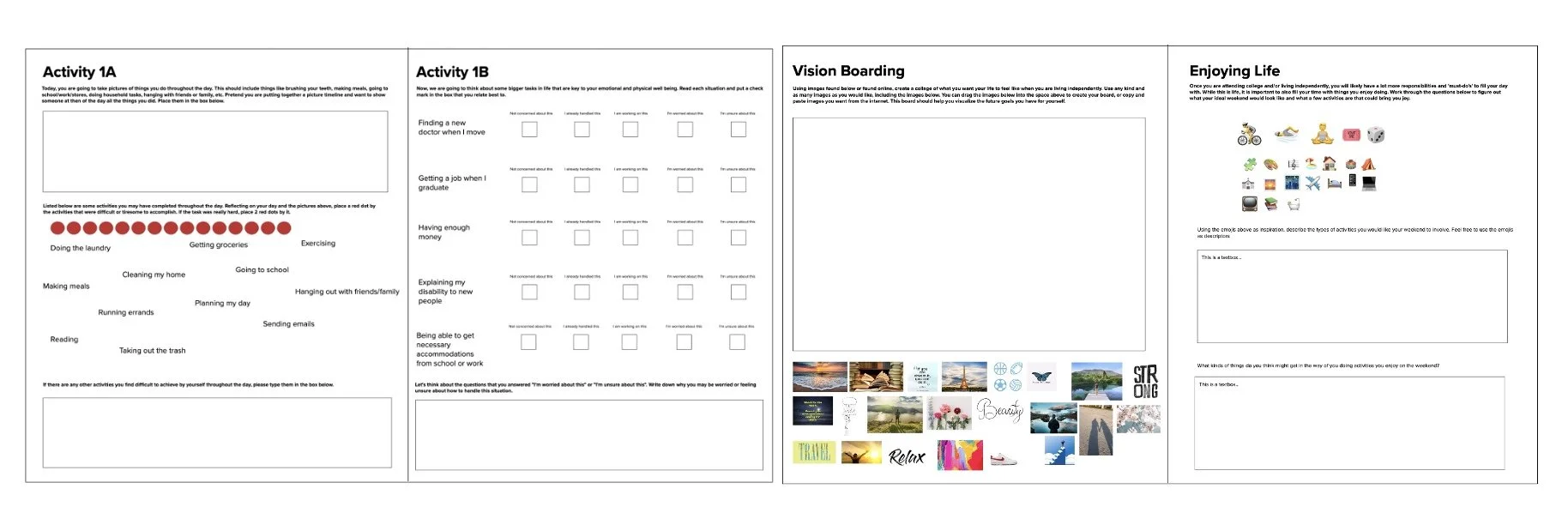
Beyond
Project Overview
For the completion of my master’s degree, each student was tasked with completing an individual thesis project. After determining I wanted to focus on designing a tool for young adults with cerebral palsy, I began speaking with many individuals to understand the pain points experienced.
Ultimately, I uncovered that the idea of preparing to leave for college is extremely daunting for this population due to the lack of resources available. My goal was to develop a service that helps teens and young adults with cerebral palsy feel supported in their endeavor to receive a higher education and reach independence.
Secondary Research
After deciding to pursue this topic, I conducted secondary research to learn more about cerebral palsy and the resources that currently exist for these young adults. My secondary research included internet searches, joining Facebook groups, attending conferences, listening to podcasts, and observing a few support groups in order to build empathy for the user.
This secondary research helped me to better understand what life is like for those with cerebral palsy. I was able to silently watch and listen in order to gain perspective on the types of problems these individuals face.
Attended a conference on inclusion within design
A Facebook group I joined to listen and learn
User Research
With a clearer idea for this project’s direction, I began user research by speaking with over 15 individuals with Cerebral Palsy. I spoke with people ranging from 17 to 26 years old in order to understand what their transition from high school to secondary education was like.
Anne represents the individuals I spoke with and helps me tell their story.
Anne is a sophomore in high school currently, and she was diagnosed with mild spastic cerebral palsy at birth. She is starting to think about her options after high school and is realizing the process may be more difficult than she thought.
”I was really excited to start looking at colleges, but then I realized how hard it is for someone with my disabilities.”
She recognizes that everyone experiences stress around growing up, but people with cerebral palsy have more to worry about, like making sure they get any academic or physical accommodations, and if schools are willing to work with them.
When Anne has to decide where to apply, she feels she has no choice but to stay at or close to home.
“If I can’t be sure about the right school for me, how could I ever survive on my own?”
I mapped out Anne’s emotional journey, indicated by the green points, as she works through the college search process. We see that she has negative experiences surrounding really trying to understand her full options and being able to make a decision. Comparing this to the average person’s journey, indicated by the grey points, we see that Anne has a much harder time during the second half of the process.
Throughout the research process, I developed 3 main emotional insights based on Anne’s current experience:
There is amplified difficulty in those with cerebral palsy finding the right college.
Knowing your own needs is a necessity for those with cerebral palsy.
Feelings of being forgotten are prevalent amongst the older cerebral palsy community.
Solution
With this in mind, I developed Beyond, a service to help teens and young adults with cerebral palsy learn about themselves and their needs by providing them with guiding resources to find the right college for them. Key features included with this service are an online journal that Anne can spend multiple months working through to learn about herself in a fun and engaging way. After finishing the journal, the Beyond team assesses Anne’s answers and will send her back a college prep kit filled with a variety of resources, guides, and fun items to help her with her college search. One of the resources in her kit will be her step by step guide that walks her through her personalized check list for researching colleges.
Background Work
After identifying the problem space I wanted to address, I developed 3 How Might We statements that would drive ideation. The goal was to create as many possible solutions as I could think of in order to provide me with a direction to start considering for lo-fi prototyping and a second round of user research.
I developed a story board to help show a second round of users the idea I had developed. Feedback from interviewees, as well as peers, helped me to refine the details of this idea before moving into higher fidelity prototyping.
During my 3rd round of testing, I presented users with a mock up of the journal activities I was considering including. Having interviewees complete these journal prompts and provide feedback allowed me to consider the type of activities that would be most helpful to include.
I went through several design iterations when considering what an online journaling experience could look like. My goal was to create an interactive, yet mature experience for older teens and young adults who would be engaging with the site.
The final piece of the Beyond product includes a box that is shipped to users where they will receive recommendations based on their online journal, as well as fun treats to get them excited for the next stage of life.












